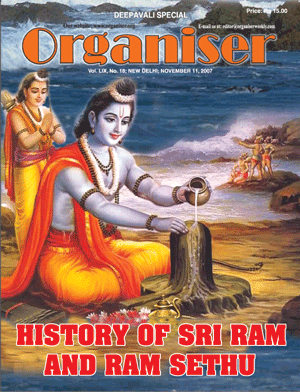
Organiser Online
Sunday, 11 November 2007

The issues of “existence of Ram” and “Ram Sethu” have posed new questions before us. The belief that “the archaeological evidence stands above all for providing the existence of the past”, requires critical examination. Should then all the personages whose names have been mentioned in authoritative literature be put at the bar of non-acceptance if there is no archaeological evidence?
If their credibility is questioned then the references of the names of persons found in hundreds of genealogical lists or pattavalies (the chronological lists of the religious heads) or namavalies (the list of the names of prominent persons) would become meaningless.
There is mention of hundreds and hundreds of kings and householders who where the followers of the Shramana tradition in the literature of both the Jains and Buddhists. Also in the Vedic literature, there is mention of many royal dynasties and rishi campuses. Then the credibility of all these allusions would become dubious.
There have been two traditions of literature - realistic and eulogistic. In the former, there is mention of only facts and figures, while in the latter there is place for exaggerative mention and possibility of presenting the ordinary events in the garb of something extraordinary of fanciful colouration and perspectives. As far as the names refered to in the genealogical lists or pattavalies are concerned, there is no base for rejecting outright their truthfulness or considering them totally invalid. Yes, whatever is said about them (those persons) or whatever description about their greatness is given, may have the shadow of eulogism, and hence, one may be skeptic about their veracity.
There is no scope for any doubt about the existence of Ram. The description of his greatness may have the shadow of eulogism, and so its validity is subject to doubt. But denial of existence of Ram cannot be justified by any angle of reasoning.
There is plethora of literature on the biography of Ram. The Ramayana of Valmiki is of course the most eminent.
The Jain version of Ramayana is found is several works of Jain tradition:
- Paumcariyam by Vimal Suri in Prakrit, about 1st to 3rd Century A.D.
- Padmapuran by Ravisena in Sanskrit, 678 A.D.
- Pampa Ramayan by Pampa in Kannada.
- Paumcariu by Svayambhu in Apabhramsa, 8th Century A.D.
- Ramacaritra by Yati Kesaraj in Gujarati missed with Rajasthani.
Ram Sethu
There is no mention of Ram Sethu in any version of Jain Ramayana. However, there is mention of two kings named “Samudra” and “Sethu” in the midst of the samudra, i.e., ocean. This may open the door of research on the issue. What is required at present is that the gates to research should not be closed and the duty of the government is that the people’s sentiments should not be hurt in any case.
Moreover, the other aspects of the issues are also important, one of them being the environmental/ecological aspect. In the context of the global perspective, nothing should be done which would adversely effect in any way the above aspect.